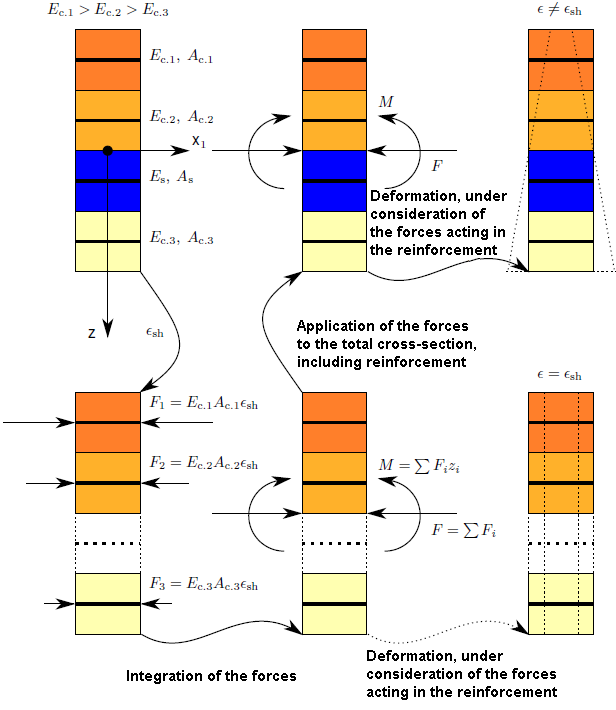Taking shrinkage into account
Shrinkage describes a time-dependent change of the volume without the effect of external loads or temperature. This manual will not go into details regarding shrinkage problems and their individual types (drying shrinkage, autogenous shrinkage, plastic shrinkage, and carbonation shrinkage).
Significant influence values of shrinkage are relative humidity, effective thickness of structural components, aggregate, concrete strength, water-cement ratio, temperature, as well as the type and duration of curing. The shrinkage-determining value is the total shrinkage strain εcs at the considered point of time t.
According to EN 1992-1-1, clause 3.1.4, the total shrinkage strain εcs is composed of the components for drying shrinkage εcd and autogenous shrinkage εca :
εcs = εcd + εca
Equation 2.101 [7] Eq. (3.8)
The component from drying shrinkage εcd is determined as follows.
εcd (t) = βds (t,ts ) · kh · εcd,0
Equation 2.102 [7] Eq. (3.9)
where
|
t |
Age of concrete at relevant point of time in days |
|
ts |
Age of concrete when shrinkage starts in days |
|
h0 |
Effective thickness of structural component [mm] (for surfaces: h0 = h) |
|
kh |
Coefficient according to [4] Table 3.3, depending on the effective cross-section thickness h0 |
|
εcd,0 |
Basic value according to [4], Table 3.2, or Annex B, Eq. (B.11) |
|
Ac |
Cross-sectional area |
|
u |
Cross-section perimeter |
|
αds1, αds2 |
Factors for considering the type of cement (see Table 2.3) |
|
fcm |
Mean cylinder compressive strength of concrete in [N/mm²] |
|
fcmo |
= 10 N/mm² |
| 32,5 N | S | slow-hardening | 3 | 0.13 |
| 32,5 R; 42,5 R | N | normal-hardening | 4 | 0.12 |
| 42,5 R; 52,5 N/R | R | rapid-hardening | 6 | 0.11 |
The autogenous shrinkage strain εca is determined as follows.
εca (t) = βas (t) · εca (∞) [7] Eq. (3.11)
where
t - in days
Taking shrinkage in RF-CONCRETE NL into account (while considering the reinforcement)
The data for the shrinkage strain is entered in window 1.3 Surfaces. In it, you can specify the age of concrete at the relevant point of time and at the beginning of shrinkage, the relative air humidity, and the type of cement. Based on these specifications, RF-CONCRETE NL determines the shrinkage strain εcs.
The shrinkage strain εcs (t,ts) can also be specified manually, independent of standards.
The shrinkage strain is only applied to the concrete layers; the reinforcement layers remain unconsidered. Thus, there is a difference from the classical temperature loading, which also affects the reinforcement layers. Therefore, the model for shrinkage used in RF-CONCRETE NL considers the restraint of the shrinkage strain εsh that is exerted by the reinforcement or the cross-section curvature for an unsymmetrical reinforcement. The resulting loads from the shrinkage strain are automatically applied to the surfaces as virtual loads and calculated. Depending on the structural system, the shrinkage strain results in additional stresses (statically indeterminate system) or additional deformations (statically determinate system). For shrinkage, RF-CONCRETE NL therefore considers the influence of the structural boundary conditions in different ways.
The loads resulting from shrinkage are automatically assigned to the loading for serviceability defined in window 1.1 General Data and are therefore included in the nonlinear calculation.
The shrinkage depends on the correct distribution of the stiffness in the cross-section. Therefore, the consideration of tension stiffening (residual tensile strength of concrete according to Quast) as well as a small value for damping are recommended for the concrete's tension zone.
The 1D model shown in Figure 2.148 illustrates how shrinkage is considered in the program.
As a simplification, four layers are considered: The dark orange layers represent the concrete with little damage, the light orange layers the more heavily damaged concrete. The blue layer corresponds to the reinforcement. Each concrete layer is characterized by the actual modulus of elasticity Ec,i and each cross-sectional area by Ac,i. The reinforcement is characterized by the actual modulus of elasticity Es and the cross-sectional area As. Each layer is described by means of the coordinate zi.
Consideration of shrinkage as an external load
Shrinkage strain can also be applied as an external load in RFEM: In the New Surface Load dialog box of RFEM, you can open the Generate Surface Load Due to Shrinkage dialog box by clicking the button shown on the left.
In this dialog box, you can enter the parameters for determining the shrinkage strain. To transfer the determined shrinkage value as a load magnitude into the initial dialog box, New Surface Load, click [OK]. The load type is automatically set to Axial strain. Please note that the shrinkage strain acts on the entire cross-section and that possible restraints or cross-section curvatures are not taken into account by the reinforcement.
Literature
[4] Quast, Ulrich. For contribution of concrete in tension zone. Beton und Stahlbetonbau, magazine 10, 1981.
[7] EN 1992-1-1: (2011). Eurocode 2: Design of Concrete Structures – Part 1-1: General Rules and Rules for Buildings, EN 1993-1-1:2005. Berlin: Beuth Verlag GmbH.


